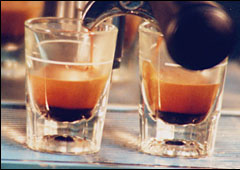
Crema
Espresso is approximately one ounce of a dark, smooth, heavy-bodied, aromatic, bittersweet coffee drink topped by a thick reddish-brown foam of tiny bubbles. It is not six times stronger than a cup of coffee, as many people imply from the smaller volume; it is actually a completely different coffee beverage. The foam, or crema, that captures the intense coffee flavors is as important as the liquid coffee underneath.
- The Coffee Ratings Blog Visits Josuma Coffee Company. Read the Trip Report>>>
- Food Channel tastes Malabar Gold Espresso at the Fancy Food Show. View the Video>>>
In more technical terms, espresso is a colloidal dispersion produced by emulsifying the insoluble oils in ground coffee. These oils don’t normally mix with water, but under the intense pressure (9 to 10 bars) generated by commercial espresso machines, these oils are extracted from ground coffee, formed into microscopic droplets, and suspended in liquid coffee concentrate. It is this emulsification of oils, which forms the crema, that distinguishes an espresso from strong coffee.
Crema markedly alters an espresso in terms of its mouth feel, density, viscosity, wetting power, and foam-forming ability, making it the single most important indicator of espresso quality. If there is no crema, it means the oils have not been emulsified, and hence it is not an espresso.
Crema also captures the volatile vapors produced during the espresso extraction process. These aroma molecules, later released in the mouth as the espresso is consumed, find their way to the nasal cavity through the pharynx. They also attach themselves to the taste buds and slowly release volatile compounds until after the espresso is long gone. This accounts for an espresso’s aftertaste, an important quality indicator.
The remarkable thing about a properly made espresso is that maximum flavor is extracted from the ground coffee while much of the caffeine and excess acids are left behind. The high pressure of the extraction and the small volume of water that passes through the ground coffee are mostly responsible for this feat.
To learn more about espresso, review our Crash Course in Coffee Science.
You can also find other articles we’ve published on Espresso Extraction in the Education Section of this website.